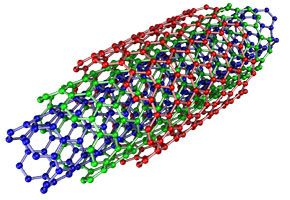

Electrochemical system could result in a device that quickly measures the levels of an amino acid essential to several biological functions in the body (illustration: Wikimedia)
Electrochemical system could result in a device that quickly measures the levels of an amino acid essential to several biological functions in the body.
Electrochemical system could result in a device that quickly measures the levels of an amino acid essential to several biological functions in the body.

Electrochemical system could result in a device that quickly measures the levels of an amino acid essential to several biological functions in the body (illustration: Wikimedia)
By Elton Alisson
Agência FAPESP – In the near future, measurement of the body’s levels of cysteine – an amino acid essential to several biological functions – may be carried out using a system that is cheaper, more practical and provides results more quickly than those that exist today.
A group of researchers at the Institute of Chemistry of the University of Campinas (Unicamp) and the National Institute of Bioanalytical Science and Technology – one of the INCTs funded by FAPESP and the National Council for Scientific and Technological Development (CNPq) – has developed a chemical sensor that could result in the development of a device to rapidly detect cysteine, one of the components of proteins in humans.
The result of doctoral and post-doctoral research conducted on FAPESP fellowships, the process of developing the chemical sensor was described in an article published in the journal Electrochimica Acta. Its findings were the subject of a presentation given on February 26, 2014 during the UK-Brazil-Chile Frontiers of Science symposium.
The Royal Society of the United Kingdom, FAPESP and the Brazilian and Chilean Academies of Sciences organized the event in Chicheley, southern England, to promote scientific and interdisciplinary collaboration among young researchers from Brazil, Chile and the UK in fields on the frontiers of knowledge.
“The idea, starting from the chemical sensor we have developed, was to build a device for the rapid detection of cysteine and several other molecules of interest to biology that could be utilized to diagnose diseases,” André Luiz Barboza Formiga, professor at the Institute of Chemistry at Unicamp and one of the project researchers, told Agência FAPESP.
According to Formiga, cysteine is a precursor to glutathione, an antioxidant compound, which prevents the formation of free radicals in the body.
In situations of oxidative stress – a biological process in which there is an imbalance between the formation and elimination of oxidizing agents in the body that is related to various diseases such as Parkinson’s disease, Alzheimer’s disease, leukemia and diabetes – there is a decrease in the levels of this sulfur-containing amino acid in the blood, explained the researcher.
To determine the cysteine level in patients’ blood and conduct the medical diagnosis of several diseases, methods of laboratory analysis based on spectroscopy (which examines the interaction of light with molecules) and liquid chromatography (a technique to separate the components of a mixture) have been developed, Formiga explained.
The problem with using these methods of laboratory analysis, says the researcher, is that they are expensive and their results take a long time to acquire. That is why the Brazilian researchers want to develop a simpler, cheaper and more rapid method of detection.
“Our goal is to come up with a device similar to the glucose monitors or pregnancy tests sold in drugstores that patients could use themselves to measure and analyze their cysteine levels,” Formiga explained.
Electrochemical sensor
To achieve this goal, the researchers modified a carbon vitreous electrode, using a carbon nanotube coating (one billionth of a meter thick) in addition to a synthetic polymer and a compound containing a transition metal (situated between the alkaline-earth metals and the semi-metals on the periodic table).
Modification of the vitreous carbon electrode resulted in a material formed by the dispersion of the carbon nanotubes in the polymer that is highly sensitive to cysteine, as determined through its increased electrochemical activity.
“The material is able to detect the amino acid in the nanomole range [a billionth of the concentration of a substance] per liter,” Formiga said.
Using this same strategy of modifying electrodes with carbon nanotubes and a natural polymer, the researchers have also developed an electrochemical system capable of detecting glutathione by using the glutathione reductase enzyme – part of the enzymatic cellular antioxidant defense system and important in the analysis of oxidative stress.
In another study, they modified luminescent polymer nanoparticles capable of immobilizing a molecule on their surface to diagnose dengue.
“Our goal is to develop chemical systems for biomedical applications,” Formiga stated.
“We were inspired by how biological systems detect molecules inside the body, and we tried to mimic it in the laboratory,” the researcher said.
The article, Modified electrode using multi-walled carbon nanotubes and a metal polymer for amperometric detection of l-cysteine (doi: 10.1016/j.electacta.2013.09.050), by Formiga et al., may be read in the journal Electrochimica Acta at www.sciencedirect.com/science/article/pii/S0013468613018124#.
Republish
The Agency FAPESP licenses news via Creative Commons (CC-BY-NC-ND) so that they can be republished free of charge and in a simple way by other digital or printed vehicles. Agência FAPESP must be credited as the source of the content being republished and the name of the reporter (if any) must be attributed. Using the HMTL button below allows compliance with these rules, detailed in Digital Republishing Policy FAPESP.




